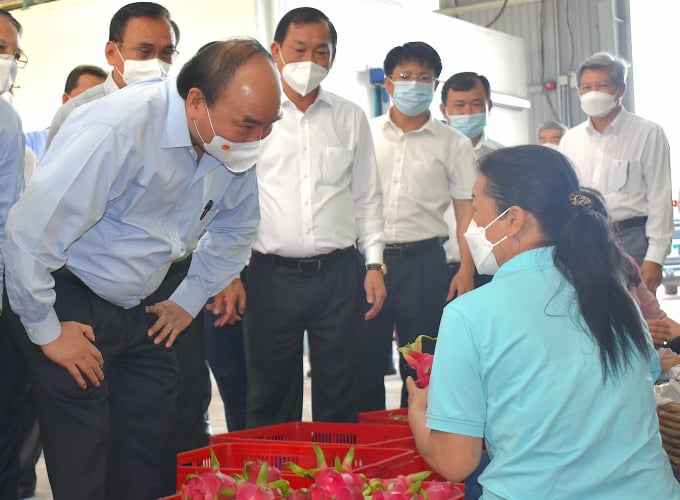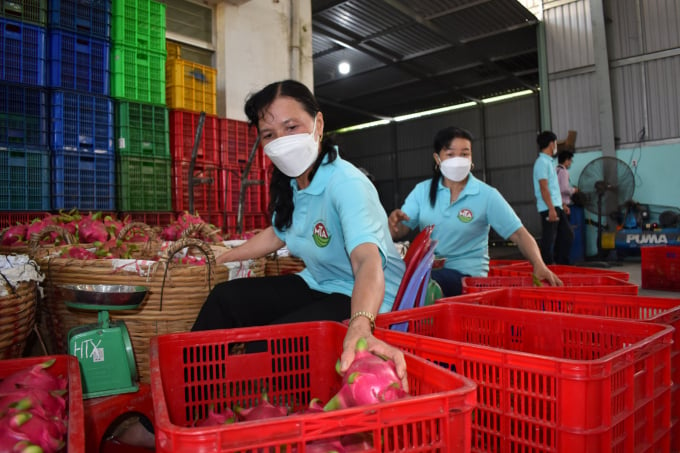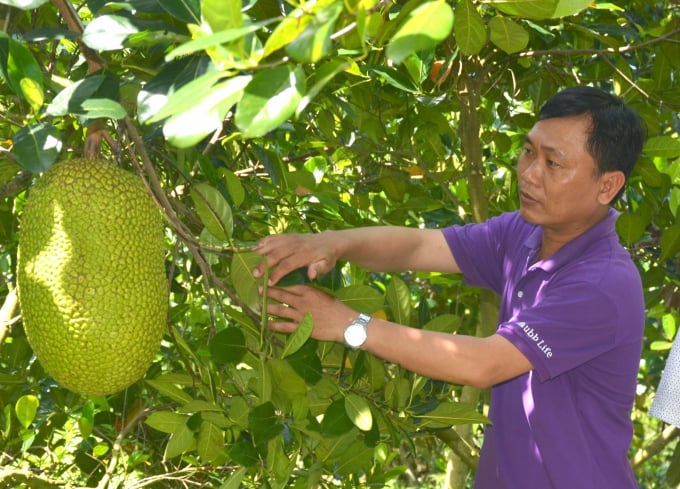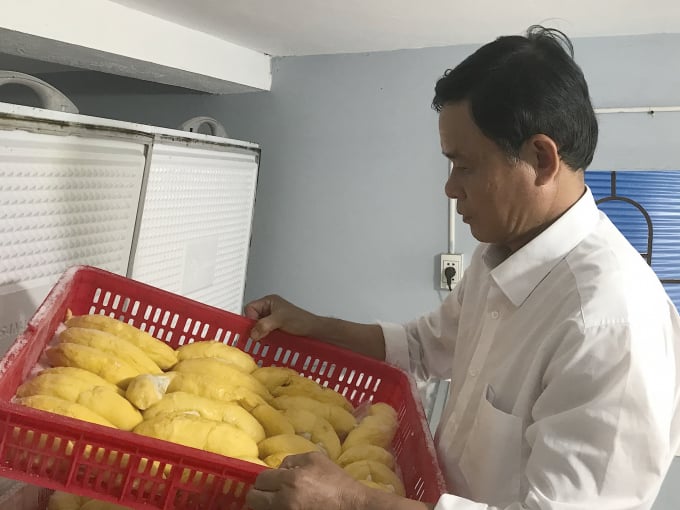May 22, 2025 | 11:57 GMT +7
May 22, 2025 | 11:57 GMT +7
Hotline: 0913.378.918
May 22, 2025 | 11:57 GMT +7
Hotline: 0913.378.918
Tien Giang province, the land located in the northern part of the Tien River, has 172 agricultural cooperatives with about 40,000 members. Compared to many other localities in the Southwest, the figures seem relatively small, even somewhat modest.
The days of establishing agricultural cooperatives, "mounding" members in according to the new rural quota system are long gone. Cooperatives being "clinically dead but not buried" because they were entangled in something else like soulless zombies is also a thing of distant past. For collective economy of the present, if it doesn’t develop in essence, only death awaits.
“We have organized a review in recent times, shut down and dissolved twelve cooperatives. Even the province's only agriculture cooperative union had made a plan for voluntary or forced dissolution. Don't be worried that disbanding means losing the cooperative quota. Because once we have determined that collective economy is an inevitable trend, losing one cooperative, and a better replacement will rise,” said Mr. Le Minh Khanh, Vice Chairman of Tien Giang Cooperative Union.

President Nguyen Xuan Phuc visits My Tinh An Cooperative in Tien Giang. Photo: Minh Dam.
After relaying decisive policies, today, when going down the Tien River, passing through the rice fields of Cho Gao and Chau Thanh, the fruit orchards of Cai Lay and Cai Be, the cooperative economic models in Tien Giang has indeed refreshed. The rice growing area, with cooperatives such as My Trinh, Green Vina TG, My Thanh Bac, My Trung and cooperatives specializing in agricultural and rural services such as Binh Nhi, Tang Hoa, and Phu Quoi have succeeded in building large fields and rice value chains with a scale of up to thousands of members.
In early April this year, a special event took place at My Tinh An Cooperative (Cho Gao district) - a dragon fruit growing area along the banks of the Tien River. President Nguyen Xuan Phuc, a person who is very passionate about the collective economy, visited this fruit cooperative model during his visit to Tien Giang.
Of course, in terms of scale, revenue and profit, My Tinh An is not large, but to the President, the enthusiasm of young people who leave the city and return to their hometowns to undo the "knots" of the new agricultural cooperative model is a precious thing.
Both Vo Chi Thien and Van Tan Phuong, leaders of My Tinh An Cooperative are young people - children of their homeland. Like many other young people, they finished university and applied for a job in Ho Chi Minh city. In their dreams and ambitions, they never thought they would one day be a farmer. But every time they returned to visit their fathers and mothers before their eyes were the scene of people struggling in the situation of “good harvest - bad price” including their loved ones. Year after year of such "rule of life", in 2009 Phuong Phuong and Thien decided to return.
My Tinh An commune actually had an agricultural cooperative in the past, but there were only a few dozen member households. "People inside are bored, people outside don't want to come in" - that was the situation back then. Reputed as a cooperative bringing people to buy and sell together, the service for members was not available, and in the harvest season, dragon fruits were thrown all over the orchards. People didn't know what to do with the stagnation of output.
My Tinh An Cooperative was established when people's trust in collective economic model hit rock bottom. The apparatus had only seven people, and although four of them have university degrees, the question of how to get people to trust and join the association seemed difficult. It took many years of trials and errors. Many times they felt depressed and had the thought of giving up. After struggling to push through by utilizing all forms of support from state agencies, My Tinh An was able to convince a number of households to participate.
“After more than 10 years of hard work, now My Tinh An Cooperative has 250 members, managing an area of 300 ha. We are the direct export partner which has signed consumption association contracts with companies such as Mekong Fruit and Vegetable Co., Ltd; An Phu Co., Ltd; Vietnam Exotic Fruit Co., Ltd; Vietnam Tropical Fruit Co., Ltd; Anh Duong Sao Co., Ltd; Red Dragon Co., Ltd; Permanent Green Co., Ltd. Every year the cooperative produces approximately 3,500 - 4,000 tons of dragon fruit, and every month 30,000 - 40,000 coconuts go to Europe, Japan, Australia and China through the cooperative,” said Vo Chi Thien.

My Tinh An Cooperative has changed the mindset about collective economy in the “capital of dragon fruit”. Photo: Minh Dam.
My Tinh An Cooperative’s biggest lesson is that if it can gain trust and keep its credibility with farmers from production organization to market consumption, the cooperative will be a success.
Unlike the old-fashioned agricultural cooperatives, My Tinh An is always looking for new solutions with a firm commitment to helping farmers. For example, the cooperative opens a store to supply agro-input, selecting quality products to provide members with original prices in the form of recording debt. When it’s time to harvest, the debt will be offset and no interest will be charged. Commitment contracts are also signed between the cooperative and members at a price of 10,000 VND/kg to ensure that if the market price dropped, farmers will not be affected. In case the market price is high, the cooperative commits to purchase with a price at least VND 1,000/kg higher.
The problem concerning market has been resolved, but perhaps the biggest achievement the young men in My Tinh An have done is the changes in farmers’ mindset regarding product quality. 100 ha of dragon fruit meets GlobalGAP standard, and 100 ha of organic coconut are under implementation. The entire production procedure is in compliance with the instructions of the technical staff. The dragon fruit growing model using LED light has solved the situation of having a shortage of goods for export to meticulous markets or having an excess of goods but selling to the China market at a cheap price.
My Tinh An Cooperative's general plant care process not only helps farmers produce "hundreds of fruits as one" but affiliated businesses also fully trust to bring the goods to meticulous markets.

More and more new agricultural cooperatives are being born in Tien Giang. Photo: Minh Dam.
Recalling the visit of President Nguyen Xuan Phuc to My Tinh An, Mr. Le Minh Khanh said, ”People are still the decisive factor for the success or failure of collective economy. There are still difficulties and limitations, but if you choose someone with passion, knowledge and qualifications, someone who thinks for the collective benefit, you will surely succeed.”
Ngu Hiep commune, Cai Lay district is a rhombus-shaped island located between the confluence of Tien, Ba Lai and Ham Luong rivers. It is an alluvial area and peaceful atmosphere fruit trees are grown all year round. Garden houses lurking under the trees are like dots in a peaceful picture. For a long time, “Ngu Hiep Durian” brand has made its name in every region. The big contributor to that glory is Mr. Huynh Tan Loc, Director of Ngu Hiep Durian Cooperative.
Ngu Hiep Durian Cooperative was established in 2008, but Mr. Loc has only taken over since 2013. It was the five years that the current director of Ngu Hiep used the word "tragic" to describe.
“There were no infrastructure facilities back then. Although durian was very delicious, we didn’t know who to sell it to, and after encouraging the locals, only a few households join the cooperative. The whole Ngu Hiep had 1,400 ha of durian planting, harvesting thousands of tons every year, but every time traders came to put pressure on the prices, people were one to suffer.”

Mr. Huynh Tan Loc, Director of Ngu Hiep Durian Cooperative. Photo: Minh Dam.
In 2013, the first thing Mr. Loc did after being elected as the Director of Ngu Hiep Durian Cooperative was to find the market. From Lao Cai, Hanoi, Can Tho, Saigon, wherever a fair was held, the director of the durian cooperative would come. He went to understand his strength and weakness, how good or bad his products were, and what standards the market required, and came back to convey what he had learned to people to help them do things right.
Also thanks to "going hard" like that, Ngu Hiep Durian Cooperative has had orders to Japan and Korea in turn. Last year, Mr. Loc also rented out the frontal land in District 1 - Ho Chi Minh city to make a store to display the cooperative's products. “If you want to do any business, you have to promote it so that people know how good your products are. Everyone says his product is the best, but no one knows how delicious it is. That’s already a failure.”
Now Ngu Hiep Durian Cooperative is strongest in “the capital of fruit” Cai Lay. Although there are only 100 official members, each member is a typical example of orchard economic development. Each household has an average of 2-3,000 m2 of land planting 60 durian trees a year and earning approximately VND 10 million per tree. All the trees are planted according to VietGAP standards and have been granted a planting area code. The next goal of Ngu Hiep Durian Cooperative is the qualification for organic standards.
“The cooperative supplies input supply, underwrites output, and provides services such as preliminary processing, preservation and packaging for export. The technical team guides farmers to cultivate to the standards of the most demanding markets. If it was in the past, when the time to harvest durian had come, people would be very afraid of being pressured by traders, but now, even if traders go to houses after houses to beg for purchase, it can’t be helped: all products are of the cooperative,” said farmer Nguyen Minh Khoi, who has 1 ha of durian in Hoa An hamlet.
Translated by Samuel Pham
![Reducing emissions from rice fields: [2] Farmers’ commitment to the soil](https://t.ex-cdn.com/nongnghiepmoitruong.vn/608w/files/news/2025/05/05/dsc08881jpg-nongnghiep-140632.jpg)
(VAN) Clean rice cultivation model in Thuong Tan commune, Bac Tan Uyen district, is assisting local residents in achieving sustainable agriculture by substantially reducing costs, increasing productivity, and protecting the environment.

(VAN) At the conference to disseminate Resolution No. 68, AgriS introduced its digital agricultural ecosystem and reaffirmed its commitment to accompanying the Government in promoting private sector development and sustainable agriculture.

(VAN) 'Blue Ocean - Blue Foods' initiative is designed to restore marine ecosystems and establish sustainable livelihoods for local communities by cultivating a minimum of 1,000 hectares of cottonii seaweed in the first three years.
/2025/05/21/4642-3-112707_603.jpg)
(VAN) The V-SCOPE project has made direct contributions to three out of six pillars of the Comprehensive Strategic Partnership between Vietnam and Australia.

(VAN) Facing the threat of rabies spreading to the community, Gia Lai province urgently carries out measures to vaccinate dogs and cats on a large scale.

(VAN) Disease-free livestock farming not only protects livestock herds but also stabilizes production and livelihoods for many farmers in Tuyen Quang.

(VAN) Japan's grant aid project contributes to capacity building, promoting organic agricultural production, and fostering sustainable community development in Dong Thap province.